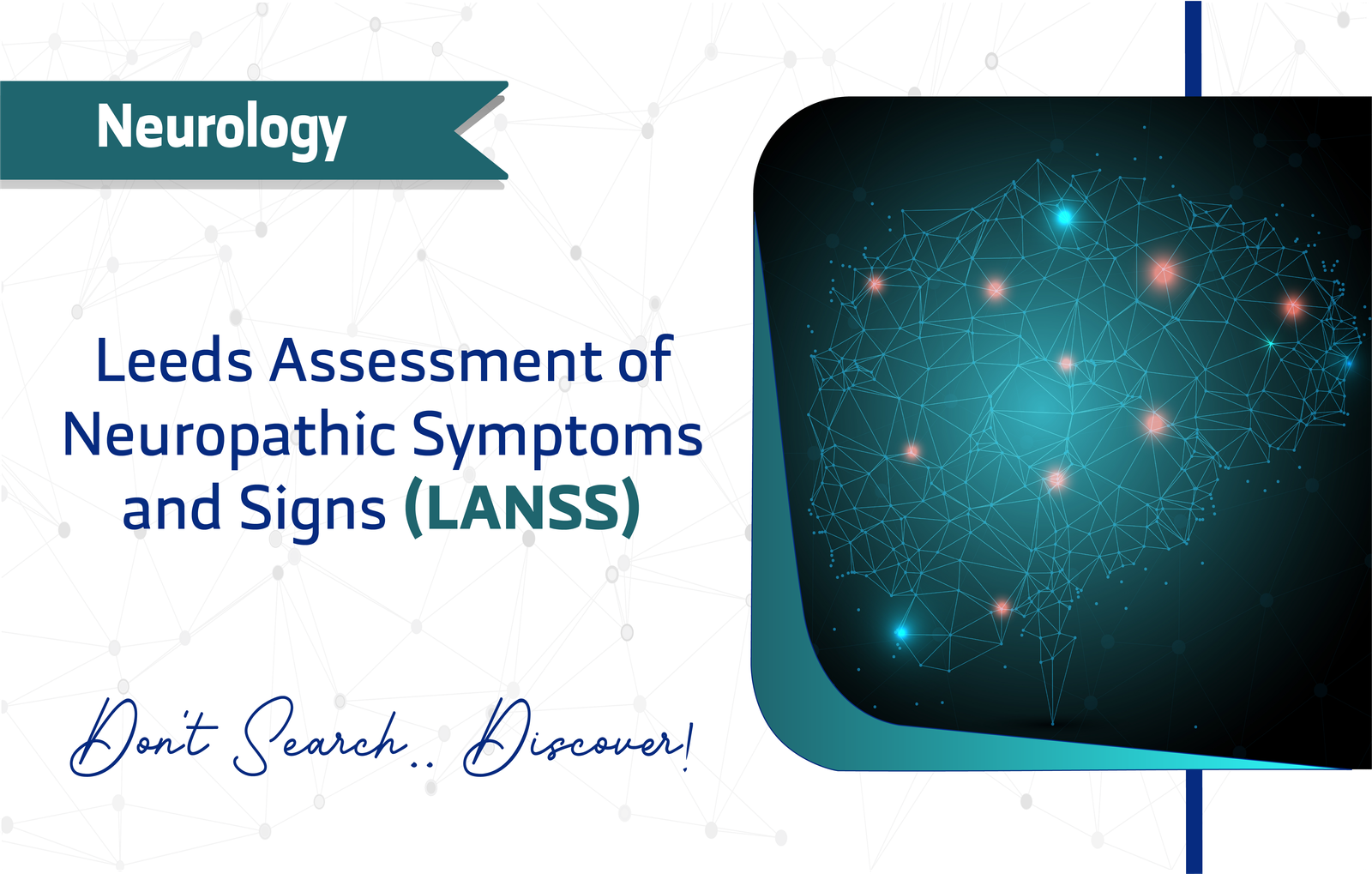Introduction
The Leeds Assessment of Neuropathic Symptoms and Signs (LANSS) Pain Scale, developed in 2001 by Michael Bennett, published by Lippincott Williams & Wilkins, is a cornerstone in neuropathic pain assessment, with over 1,600 citations for its original validation study (Bennett, 2001). As one of the earliest and most cited tools for neuropathic pain screening, it differentiates neuropathic pain from nociceptive pain, making it invaluable for researchers and clinicians. Its robust validation and ease of use establish it as a go-to instrument in pain management.
In this article, we explore the LANSS ’s features, applications, and limitations, offering insights for experts in research and practice, enhancing patient outcomes in diverse clinical settings.
Key Features of Leeds Assessment of Neuropathic Symptoms and Signs (LANSS)
Purpose and Use
The LANSS distinguishes neuropathic pain (caused by nerve damage) from nociceptive pain (caused by tissue damage). It’s widely used in clinical diagnostics and research to evaluate pain mechanisms and treatment efficacy.
Target Population
Suitable for adults across all age groups (18+), including young adults, middle-aged adults, and seniors, the LANSS is versatile for conditions like diabetic neuropathy, postherpetic neuralgia, and chronic pain syndromes.
Structure
The LANSS comprises seven items, split into five symptom-based questions and two sensory examination items. These cover sensations like prickling, burning, and allodynia, alongside clinical tests for hyperalgesia and altered pin-prick thresholds.
Scoring Method
The LANSS uses a binary scoring system for its seven items, with a maximum score of 24. Specifically:
- Symptom Questions: Five questions assess patient-reported sensations (burning, tingling, skin appearance changes, sudden pain bursts, temperature abnormalities), scored as yes (5 points) or no (0 points).
- Sensory Examination: Two items involve clinical tests (Allodynia testing -light touch with cotton-, Pin-prick threshold testing), scored as positive (5 points) or negative (0 points).
- Interpretation:
- Score < 12: Neuropathic mechanisms are unlikely to contribute to the patient’s pain.
- Score ≥ 12: Neuropathic mechanisms are likely, warranting further investigation or treatment.
This clear cutoff enhances the LANSS’s utility in quick decision-making. Moreover, its straightforward scoring minimizes complexity for clinicians.
Administration Format
The LANSS takes 5-10 minutes to administer, making it highly efficient. It can be conducted via:
- In-person interviews
Administrators must undergo basic training to ensure consistent and accurate scoring, though no advanced certification is required.
Applications of Leeds Assessment of Neuropathic Symptoms and Signs (LANSS)
The LANSS serves multiple roles in clinical and research contexts:
- Screening: Identifies neuropathic pain, enabling early intervention.
- Diagnosis: Assists in confirming neuropathic pain mechanisms.
- Research: Widely used in clinical trials to assess pain intervention outcomes.
Languages and Availability
The LANSS is available in multiple languages, including:
- English
- Spanish
- French
- German
- Portuguese
Ensuring accessibility in global research and clinical practice, although validation varies across these languages.
The LANSS is free for academic and clinical use, requiring no licensing fees, with an open access license type. However, permission is needed for commercial use. This accessibility supports its widespread adoption in research and practice.
Reliability and Validity
The LANSS is highly reliable and valid, with extensive validation across various pain conditions. Key metrics include:
- Cronbach’s Alpha: Studies report values between 0.74 and 0.82, indicating good internal consistency.
- Sensitivity and Specificity: The original validation study demonstrated 82-85% sensitivity and 80-89% specificity for identifying neuropathic pain (Bennett, 2001).
- Test-Retest Reliability: The tool shows strong consistency, with a correlation coefficient of 0.90.
Validation Studies:
- Original Study: Validated for neuropathic pain screening (Bennett, 2001). Link.
Limitations and Considerations
Despite its strengths, the LANSS has a few limitations:
- Language Barriers: Availability in multiple languages helps, but nuances in translation may affect accuracy in some populations.
- Limited Validation Studies: Limited validation in non-English languages could restrict its applicability in diverse global populations.
- Lack of Sensitivity to Change: Less sensitive for mixed pain types, potentially limiting its use in longitudinal monitoring of complex pain conditions.
- Physical Examination: The standard LANSS requires a clinical sensory exam, which may not be feasible in all settings. The S-LANSS mitigates this but may lose some diagnostic precision.
Additional Resources
For more information on the LANSS and to access the full questionnaire, visit the following resources:
- Download: Access the LANSS questionnaire as a PDF here.
- Contact: For inquiries, reach Michael Bennett at m.bennett@st-gemma.co.uk.
- Original Validation Study: Link.
Frequently Asked Questions (FAQ)
- Who can use the LANSS?
Clinicians, researchers, and healthcare providers use the LANSS for adults (18+) with suspected neuropathic pain. - How long does it take to complete the LANSS?
The LANSS takes 5–10 minutes, making it efficient for clinical and research use. - How is the LANSS administered?
It can be administered via in-person interview, offering versatile application. - Is there any cost to using the LANSS?
The LANSS is free for non-commercial use, but commercial use requires permission from the publisher. - Are there other versions of the LANSS?
Yes, the Self-Report LANSS (S-LANSS) is available for use without a clinical examination. - What are related questionnaires?
Similar tools include PainDETECT, DN4 (Douleur Neuropathique 4), and the Neuropathic Pain Questionnaire (NPQ).
A word from ResRef about Leeds Assessment of Neuropathic Symptoms and Signs (LANSS)
The Leeds Assessment of Neuropathic Symptoms and Signs (LANSS) Pain Scale is a concise, clinically valuable tool for identifying neuropathic pain, with strong validation in diverse adult populations. As one of the earliest and most cited tools for neuropathic pain screening, it offers actionable insights for researchers studying pain mechanisms or clinicians optimizing patient care. Consequently, it leads to better outcomes and informed treatment decisions.
References
- Bennett M. The LANSS Pain Scale: the Leeds assessment of neuropathic symptoms and signs. Pain. 2001 May;92(1-2):147-57. doi: 10.1016/s0304-3959(00)00482-6. PMID: 11323136. (link)








